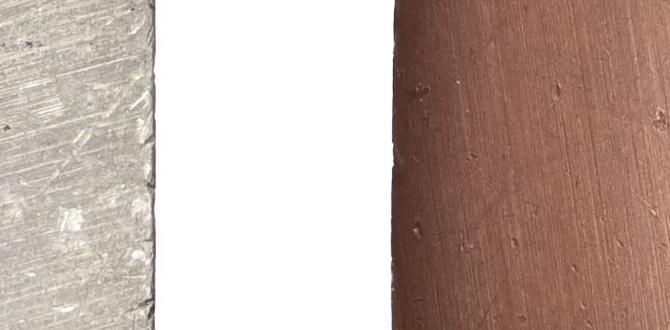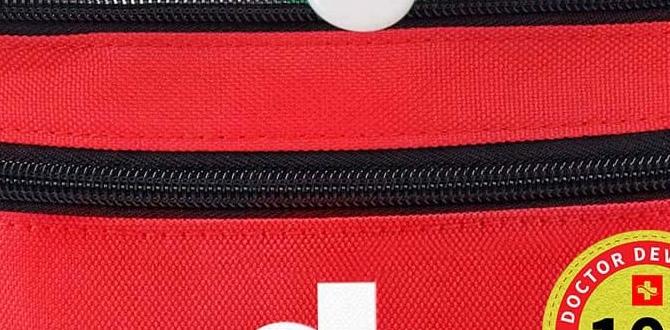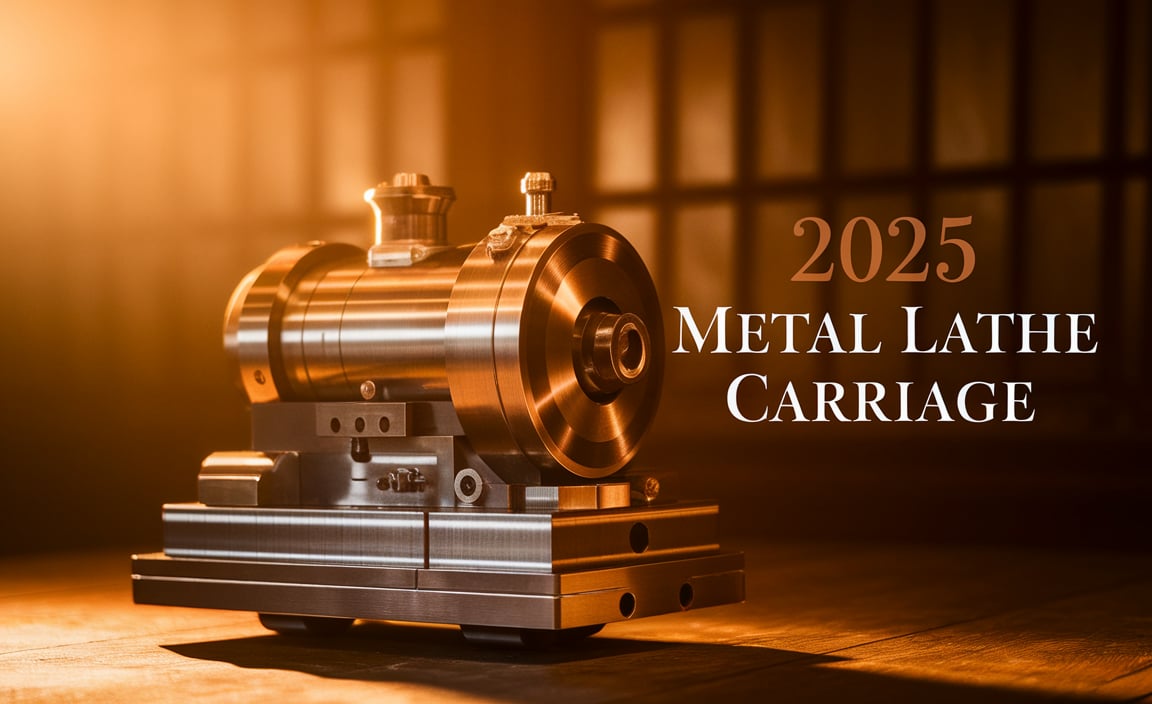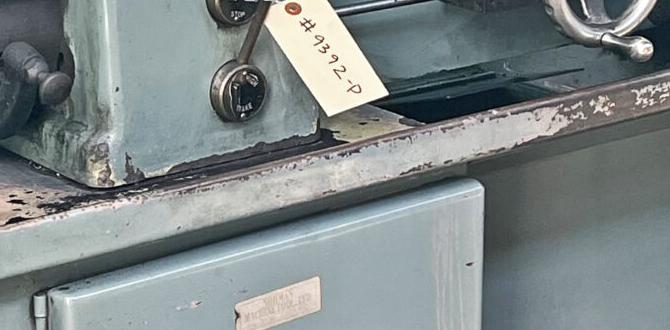Quick Summary: A centering tool for a lathe is crucial for accurately marking the center point on a workpiece. This ensures stable mounting between centers, preventing wobble and enabling precise turning for professional results. This guide will show you how to choose, use, and maintain one.
Ever feel like your lathe projects just aren’t quite as precise as you’d like? Perhaps your workpiece wobbles a bit on the headstock and tailstock, or maybe you’re struggling to get that perfectly symmetrical shape. You’re not alone! Getting a workpiece perfectly centered is a fundamental step in lathe work, and it’s where many beginners stumble. A simple, yet incredibly effective tool can solve this frustration: the lathe centering tool. Think of it as your secret weapon for achieving smooth, accurate, and professional-looking results every time you turn. In this guide, we’ll demystify the centering tool, show you exactly why it’s so important, and walk you through how to use it with confidence. Let’s get your projects spinning true!
Why You Absolutely Need a Lathe Centering Tool
Imagine trying to build a perfectly round wheel for a cart, but your spokes are all slightly off-center. That’s what happens when your workpiece isn’t properly centered on your lathe. When you mount a piece of material between the headstock and tailstock centers without accurate alignment, several problems can arise:
- Wobble and Vibration: An off-center workpiece will inevitably vibrate and wobble, making it difficult to control your cutting tool and leading to a rough, uneven finish.
- Inaccurate Cuts: If the material isn’t spun true, your cuts won’t be concentric. This means whatever you’re trying to shape will be asymmetrical, no matter how carefully you measure.
- Increased Tool Wear: The shock and vibration from an unbalanced workpiece can put extra stress on your cutting tools, dulling them faster than usual.
- Safety Concerns: A violently vibrating workpiece can sometimes come loose, posing a significant safety hazard. Proper centering is a key safety practice.
- Frustration and Wasted Material: As a beginner, dealing with these issues can be incredibly discouraging and lead to ruined projects and wasted time.
A centering tool for a lathe is designed to pinpoint the exact center of your workpiece’s end face. This allows you to align it precisely with the lathe’s centers, ensuring a stable, true spin. It’s a small investment that pays huge dividends in accuracy, finish quality, and your overall machining experience.
Understanding Different Types of Lathe Centering Tools
While the core function is the same – finding the center – there are a few variations of centering tools you might encounter. Each has its own advantages:
1. The Center Finder (or Cone-Type Center Finder)
This is probably the most common and straightforward type for beginners. It looks like a cone with an adjustable, pointed pin or stylus on the side. It’s designed to sit on the end face of your workpiece.
- How it works: You place the cone on the face of your material. As you rotate the workpiece (either by hand or with the machine’s slowest setting), the pointed stylus follows the surface. The stylus pivots in a groove or slot that’s precisely designed to indicate the center when perfectly aligned. When the stylus’s movement is consistent and appears to be following a tiny circle all around, you’re at the center.
- Pros: Very intuitive, relatively inexpensive, excellent for general-purpose centering.
- Cons: Can be slightly less precise than some other methods for very small workpieces or if the stylus isn’t perfectly flush.
2. The Dial Indicator Center Finder
For those who demand ultimate precision, a dial indicator center finder is the way to go. This a more sophisticated tool that uses a dial indicator to measure runout.
- How it works: This tool usually has a magnetic base or a clamp that attaches to the lathe’s tool post. A long, flexible arm extends to hold a dial indicator. The indicator’s probe is then brought into contact with the end face of the workpiece. As you rotate the workpiece by hand, the dial indicator will show how much it’s deviating from the center. By adjusting the workpiece’s position until the dial shows minimal and consistent movement (ideally zero runout) in all directions, you find the true center.
- Pros: Extremely accurate, can be used for other precision alignment tasks on the lathe.
- Cons: More expensive, requires a bit more setup and understanding of dial indicators.
3. Layout Fluid and Scriber Method
This is a classic machinist’s technique that doesn’t involve a dedicated centering tool but relies on marking out. It’s often used in conjunction with a marking blue compound or layout dye.
- How it works: You apply a thin layer of layout fluid (often bright blue or red) to the end face of your workpiece. Then, you use a scriber or pencil to draw a series of arcs or lines. A common method is to draw two lines that are close to parallel, then use a compass or dividers to mark arcs from points on these lines. Another accurate method is to draw two arcs that are not perfectly concentric. The point where the scriber’s path intersects the center of these arcs, when you rotate the workpiece, is the center. For a more visual approach, you can draw two “x” marks, roughly centered, and then use a compass with a fine point to draw two non-concentric circles. The approximate center will be where the circles are closest to each other and have runout. You then refine this.
- Pros: Very low cost, accessible with basic tools, teaches fundamental layout skills.
- Cons: Less precise than dedicated tools, can be time-consuming, requires practice.
For beginners, the Center Finder is usually the recommended starting point due to its ease of use and affordability. As your skills grow, you might explore the dial indicator method for more critical work.
Tools & Materials You’ll Need
Using a centering tool is straightforward, but having the right setup makes the job easier and safer.
- Your Lathe: Ensure it’s clean and in good working order.
- The Workpiece: The material you intend to turn.
- Centering Tool: Your chosen type (Cone-Type Center Finder is a great start).
- Live Center (for tailstock): This is the pointed, spinning bit that goes into the tailstock and mates with the center mark on your workpiece. It rotates with the workpiece.
- Dead Center (for headstock): A stationary, pointed bit that often goes into the headstock’s spindle. This doesn’t spin.
- Safety Glasses: Non-negotiable for any machining operation.
- Rags and Cleaning Supplies: To keep your workspace and tools clean.
- Optional: Layout Fluid and Scriber: If you’re using that method or want to double-check.
- Optional: Dial Indicator and Magnetic Base: For advanced precision.
Safety is paramount when working with lathes. Always wear safety glasses. Ensure your workpiece is securely mounted before starting any turning operations. For initial setup, use the slowest spindle speed possible.
How to Use a Lathe Centering Tool (Step-by-Step)
Let’s focus on the most common type: the cone-style center finder. This method is perfect for marking the center on the face of wood or metal blanks that will be mounted between centers.
Step 1: Prepare Your Workpiece and Lathe
First, ensure the end face of your workpiece is relatively flat and clean. If it’s very rough, a quick pass on the face with your tool on the lathe before centering can help. Make sure your lathe is unplugged or the power is off for safety while you set up.
Step 2: Mount the Live Center
Insert the live center into your tailstock quill. Ensure it’s snug and properly seated. The tailstock should be aligned with the headstock, or slightly offset depending on your planned operation (for simple turning between centers, it should be aligned).
Step 3: Position the Workpiece
Place your workpiece on the face of the headstock’s spindle (if it’s chucked) or ready to be mounted. For this step, you’re not mounting it between centers yet, but preparing to mark its end face.
Step 4: Place the Center Finder
Take your cone-style center finder. Place the cone part over the spindle nose of the headstock (or the chuck jaw that’s holding your workpiece). The pointed stylus of the center finder should be resting on the end face of your workpiece.
Important Note: If you’re using a three-jaw chuck, loosen the chuck jaws just enough so the workpiece can be gently rotated by hand, but remains held securely. If you’re using a faceplate, ensure it’s adequately secured.
Step 5: Align the Stylus
Now, carefully rotate the workpiece by hand. As you rotate, the stylus on the center finder will follow the contours of the workpiece’s end face. It will likely move up and down or side-to-side. You’re looking for the point where the stylus makes a tiny, perfectly circular path. This means the stylus is running true, concentric with the spindle axis.
When the stylus appears to be tracing the smallest possible circle, you’ve found the center. You can then gently push the stylus down to mark the center point on the workpiece.
Tip: For metal, you might want to use a small hammer to lightly tap the side of the stylus to create a small dimple that your dead center can locate. For wood, the stylus point might be sharp enough to leave a visible mark directly.
Step 6: Mark the Center
Once you’ve found the sweet spot where the stylus traces the smallest circle and has minimal runout, use the stylus to firmly mark the center point. If you need a clearer mark, you can then use a sharp center punch (for metal) or a pointed scribe (for wood or metal) to deepen the mark.
Step 7: Mount the Workpiece Between Centers
Now, turn off the lathe’s power completely. Remove the workpiece from the chuck (if it was in one). Place the point of the dead center (usually in the headstock) into the marked center on one end of your workpiece. Place the point of the live center (in the tailstock) into the marked center on the other end of your workpiece. Bring the tailstock up to engage the workpiece, leaving just enough pressure to hold it snugly but not so much that you distort the material.
Step 8: Secure and Test
Lock the tailstock in place. Double-check that your workpiece is securely held. Turn on the lathe at its slowest speed. Give the workpiece a gentle nudge to ensure it’s not binding. If everything feels smooth, you’ve successfully centered your workpiece!
For Woodworking Lathes: The process is very similar. You’ll often have a spur center that digs into wood on the headstock side, and a live center on the tailstock. The centering tool works just the same to find the point to engage the spur center.
Using a Dial Indicator Center Finder (Advanced)
If you’re aiming for extreme accuracy, or working with large, heavy pieces, a dial indicator setup offers superior results.
Step 1: Set up the Dial Indicator
Mount the magnetic base of your dial indicator to the lathe bed, or attach it to the tool post. Alternatively, some dial indicator center finders have their own mounting arm. The goal is to position the dial indicator so its contact point can rest on the end face of your workpiece.
Step 2: Position the Workpiece
Mount your workpiece in a chuck or on a faceplate securely. Bring the tailstock up with a live center engaged in the approximate center of the workpiece’s end face. This provides some support but isn’t the primary alignment method here.
Step 3: Zero the Indicator
Carefully bring the dial indicator’s probe into contact with the end face of the workpiece. Position it as close to the geometric center as you can estimate. You might need to swing the tailstock slightly to get the indicator probe to make contact. Adjust the dial indicator’s bezel so the needle reads zero at this position.
Step 4: Rotate and Observe
Gently rotate the workpiece by hand (with the slowest spindle speed). Observe the dial indicator. It will show you the amount of “runout” – how much the point you’re measuring deviates from a perfect circle. You want this runout to be as close to zero as possible.
Step 5: Adjust and Refine
Loosen the chuck or faceplate slightly. Nudge the workpiece very slightly in the direction that reduces the maximum reading on the dial indicator. Re-tighten and rotate again. Repeat this process, making small adjustments, until the dial indicator shows minimal runout across its entire sweep when rotated. Sometimes, you might need to adjust the tailstock alignment slightly as well. A perfectly centered piece will show zero (or very close to zero) runout on the dial indicator.
This method is more time-consuming but ensures that your workpiece is perfectly concentric with the lathe’s spindle axis, which is crucial for precision turning, knurling, or threading.
Table: Choosing the Right Centering Tool
| Tool Type | Best For | Accuracy Level | Ease of Use | Cost | Notes |
| :———————– | :——————————————– | :————- | :———- | :——– | :———————————————————— |
| Center Finder (Cone) | General purpose DIY, beginner woodworking/metal | Good | High | Low | Great for most common tasks and materials. |
| Dial Indicator Center | Precision work, critical tolerances, large parts | Excellent | Medium | High | Requires understanding of dial indicators; ideal for production. |
| Layout Fluid & Scriber | Basic woodturning, manual metalwork, cost-saving | Fair to Good | Medium | Very Low | Develops essential layout skills; time-consuming. |
Tips for Accurate Centering Every Time
Mastering centering is a skill that improves with practice. Here are some tips to help you get it right:
- Start Slow: Always use the slowest spindle speed when initially getting the workpiece centered and mounted.
- Cleanliness is Key: Make sure the centers of your workpiece, the live center, and the dead center are all clean and free of debris. Even a tiny chip can cause misalignment.
- Check for Runout: After you have the workpiece roughly centered and are spinning slowly, gently bring a pencil or a scribe near the rotating surface. If the gap between the pencil and the surface changes drastically as it rotates, you have runout and need to adjust.
- The “Dimple” Method: For metal, when using a cone center finder, you can “dimple” the center mark with a center punch. Then, when mounting between centers, place the point of the tailstock center into this dimple. This helps the tailstock center find its intended spot.
- Workpiece Shape Matters: Centering is easiest on workpieces with a reasonably flat end face. If your material is very irregular, you might need to face off the ends to create a flat surface first.
- Tailstock Alignment: Ensure your tailstock is properly aligned with the headstock. An out-of-square tailstock can affect the centering. Many lathes have adjustment screws for this. You can check this by running a dial indicator along the spindle and the tailstock quill. For perfect alignment of centers, the indicator should read the same on both.
- Don’t Overtighten: When mounting between centers, apply firm pressure but avoid crushing the wood or deforming the metal.
- Use a Live Center: For turning long pieces between centers, always use a live center on the tailstock. A dead center would create immense friction and heat as it scraped against the rotating workpiece, quickly dulling both centers and potentially damaging the workpiece. Learn more about lathe accessories at Wood Magazine’s guide to lathe accessories.
Centering for Different Lathe Types
While the principles are the same, the specific tools and setup might vary slightly between metalworking and woodworking lathes.
Metal Lathes:
- Workpiece: Metal blanks, bars, rods, or castings.
- Centers: Typically use hardened steel dead centers (headstock) and live centers (tailstock).
- Centering Tool Use: Cone-type center finders are excellent for marking the end face to position the dead and live centers. For very high precision, dial indicator setups are common.
- Marking: A center punch is often used to create a small indentation at the marked center for the point of the center to engage.
- Chuck vs. Faceplate: Metal lathes often use robust chucks or faceplates to hold workpieces that are too large or awkwardly shaped for between-centers turning.






